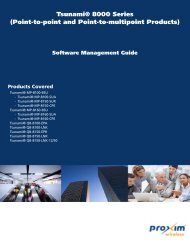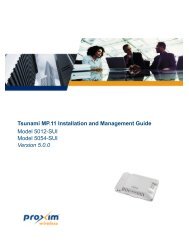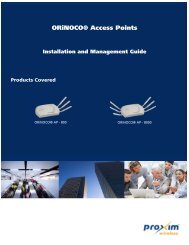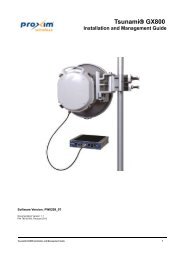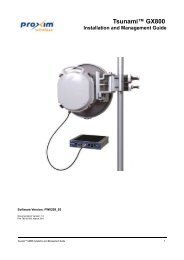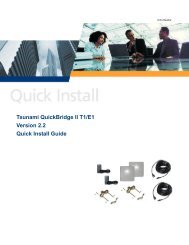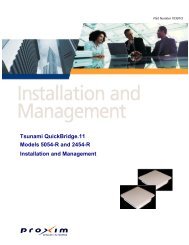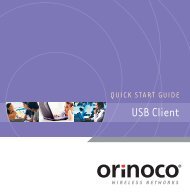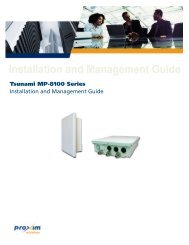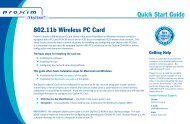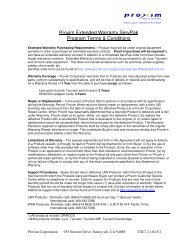Tsunami MP.11 Installation and Management Model 5012-SUR ...
Tsunami MP.11 Installation and Management Model 5012-SUR ...
Tsunami MP.11 Installation and Management Model 5012-SUR ...
You also want an ePaper? Increase the reach of your titles
YUMPU automatically turns print PDFs into web optimized ePapers that Google loves.
Configuration <strong>Tsunami</strong> <strong>MP.11</strong> <strong>5012</strong>-<strong>SUR</strong> <strong>Installation</strong> <strong>and</strong> <strong>Management</strong><br />
System Parameters<br />
• System Name: This is the system name for easy identification of the BSU or SU. The System Name field is limited to<br />
a length of 32 bytes. Use the system name of a BSU to configure the Base Station System Name parameter on an SU<br />
if you want the SU to register only with this BSU. If the Base Station System Name is left blank on the SU, it can<br />
register with any Base Station that has a matching Network Name <strong>and</strong> Network Secret.<br />
• Country: Upon choosing a country/b<strong>and</strong>, the Dynamic Frequency Selection (DFS) <strong>and</strong> Transmit Power Control (TPC)<br />
features are enabled automatically if the selected country/b<strong>and</strong> has a regulatory domain that requires it. The Country<br />
selection pre-selects <strong>and</strong> displays only the allowed frequencies for the selected country/b<strong>and</strong>.<br />
Click Configure > Interfaces > Wireless to see the channel/frequency list for the selected Country.<br />
NOTE: If All Channels 5 GHz is selected from the Country drop-down menu, any channel in the 5 GHz range are<br />
displayed for manual selection.<br />
NOTE: Units sold only in the United States are pre-configured to scan <strong>and</strong> display only the outdoor frequencies<br />
permitted by the FCC. No other Country selections, channels, or frequencies can be configured. Units sold<br />
outside of the United States support the selection of a Country by the professional installer. If you change the<br />
Country, a reboot of the unit is necessary for the upgrade to take place.<br />
For a non US-only device, the default country selected is United Kingdom (GB).<br />
Note the following:<br />
– The channel center frequencies are not regulated; only the b<strong>and</strong> edge frequencies are regulated.<br />
– If, before upgrade, US was selected as a country for a non US-Only device (which is an incorrect configuration),<br />
the country is changed automatically to United Kingdom upon upgrade.<br />
See Country Codes <strong>and</strong> Channels for a list of country codes.<br />
• Location: This field can be used to describe the location of the unit, for example “Main Lobby.”<br />
• Contact Name, Contact Email, <strong>and</strong> Contact Phone: In these fields, you can enter the details of the person to<br />
contact.<br />
• ObjectID: This read-only field shows the OID of the product name in the MIB.<br />
• Ethernet MAC Address: This read-only field shows the MAC address of the Ethernet interface of the device.<br />
• Descriptor: This read-only field shows the product name <strong>and</strong> firmware build version.<br />
• Up Time: This read-only field shows the length of time the device has been up <strong>and</strong> running since the last reboot.<br />
• Mode of Operation: This drop-down menu is used to set the unit as a bridge (layer 2) or as a router (layer 3). See<br />
Bridge <strong>and</strong> Routing Modes for more information.<br />
Bridge <strong>and</strong> Routing Modes<br />
Bridge Mode<br />
A bridge is a product that connects a local area network (LAN) to another LAN that uses the same protocol (for example,<br />
Ethernet). You can envision a bridge as being a device that decides whether a message from you to someone else is<br />
going to the local area network in your building or to someone on the local area network in the building across the street.<br />
A bridge examines each message on a LAN, passing those known to be within the same LAN, <strong>and</strong> forwarding those<br />
known to be on the other interconnected LAN (or LANs).<br />
In bridging networks, computer or node addresses have no specific relationship to location. For this reason, messages<br />
are sent out to every address on the network <strong>and</strong> are accepted only by the intended destination node. Bridges learn<br />
which addresses are on which network <strong>and</strong> develop a learning table so that subsequent messages can be forwarded to<br />
the correct network.<br />
Bridging networks are generally always interconnected LANs since broadcasting every message to all possible<br />
destination would flood a larger network with unnecessary traffic. For this reason, router networks such as the Internet<br />
use a scheme that assigns addresses to nodes so that a message or packet can be forwarded only in one general<br />
direction rather than forwarded in all directions.<br />
58





